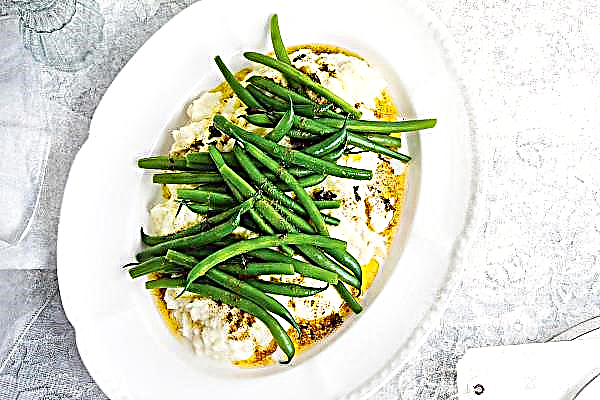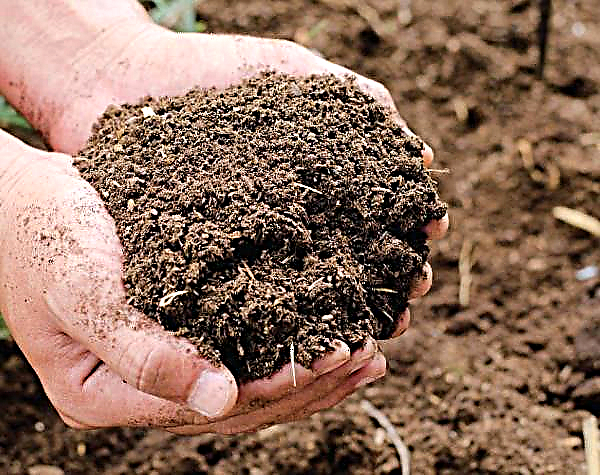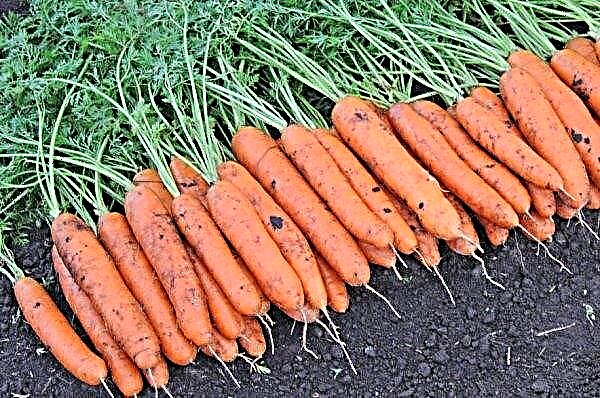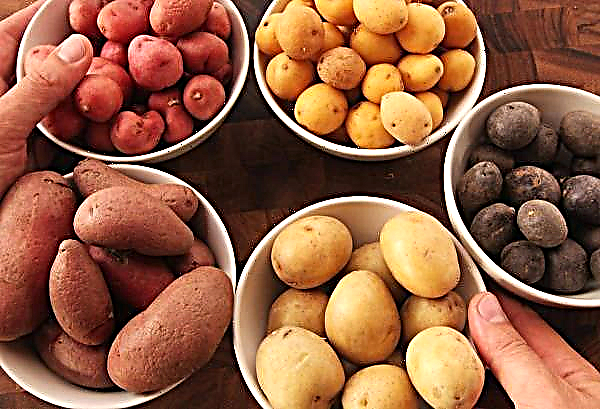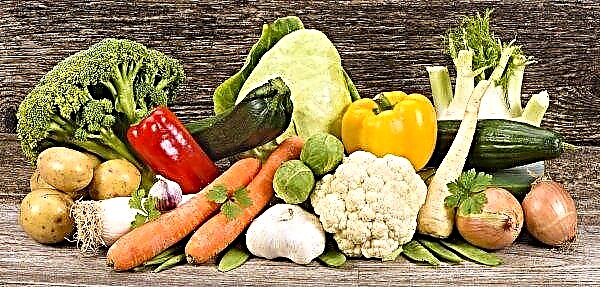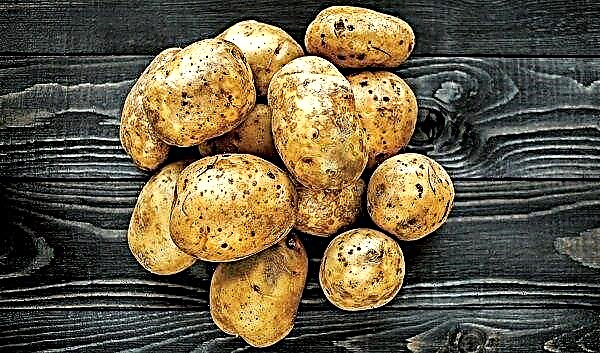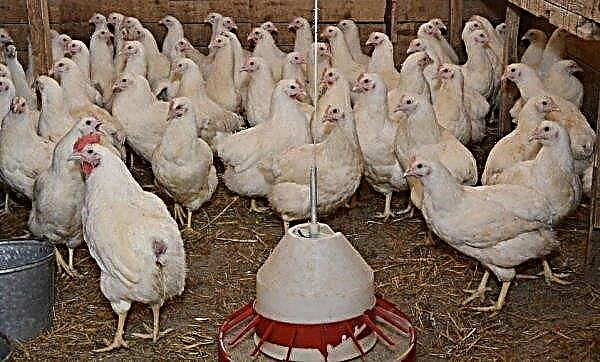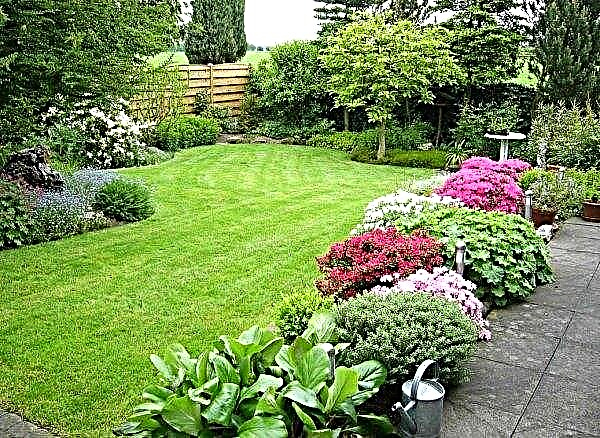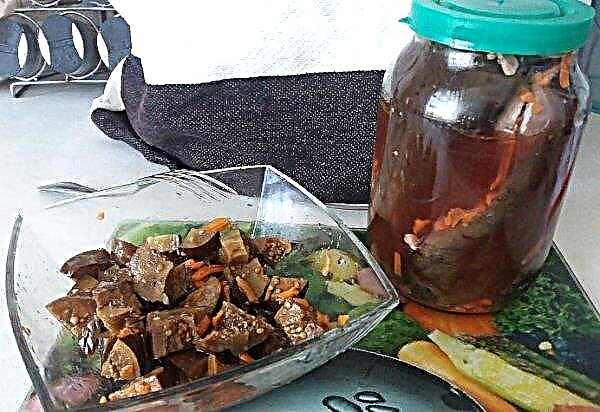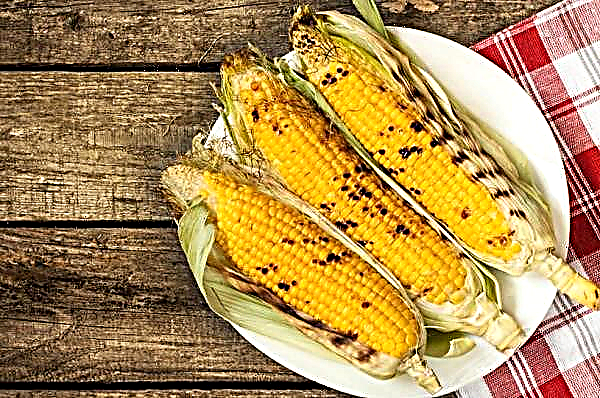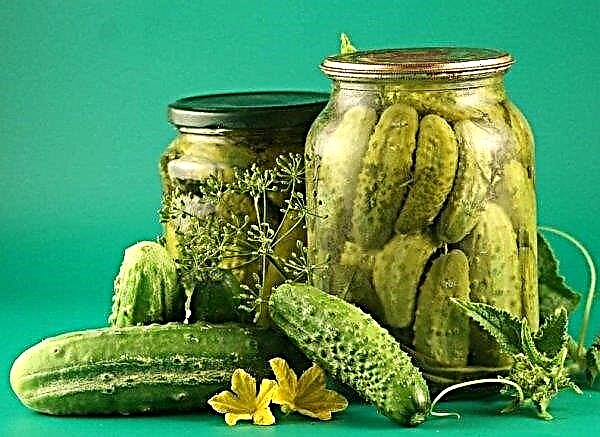Crop of tomatoes may decrease markedly in adverse rainy conditions due to late blight. This disease often affects tomatoes during their ripening. Consider how you can avoid the defeat of tomatoes with late blight with the help of boric acid, what kind of substance it is and how it can be used.
What is late blight?
Phytophthora is called mushroom-like microorganisms belonging to the order of oomycetes, which once belonged to fungi, and now they are referred to as protists.
There are more than 100 species of representatives of this genus. They cause a disease of plants (mainly from the genus Solanaceae) called late blight. Propagated by zoospores wintering on tubers, tops or in the soil. They cause considerable damage to garden crops.
Did you know? Phytophthora moved from America to Europe with solanaceous crops (tomato, potato, pepper and eggplant), and caused a massive death of the population of Ireland from starvation, spoiling the potato crop. About 1 million Irish died, and 1.5 million left the country, which caused a reduction in the population of Ireland in 1841-1851. almost a third.
The first signs of late blight on tomatoes
The first stages of late blight on tomatoes can go unnoticed, since the lesions can be uneven. First of all, brownish spots on green foliage and stems become visible, which begin to spread throughout the plant and spread to neighboring bushes. In wet weather, a white fluffy coating is observed on the lower part of the diseased leaf plate and on the stems.
Fruits begin to be affected - dark spots appear on them and begin to spread, causing changes in shape. Over time, the tomato rots, loses turgor and acquires an unpleasant putrefactive odor. Such a situation can manifest itself not only during the period of being on the bush, but also in the storage.
Causes of the disease
Zyospores of phytophthora can get on a tomato from the soil, from nearby diseased plants, and be carried by the wind, capable of transporting them over long distances. In the presence of heat (temperatures above + 10 ° C) with high humidity (more than 75%) they easily germinate and begin to multiply rapidly.
Important! Tomatoes collected from affected bushes should not be stored, but should be recycled faster. Seeds from such fruits contain phytophthora zoospores, and if you plan to use them, they must be decontaminated before planting (for example, potassium permanganate solutionI am).
The appearance of the disease in tomatoes is facilitated by:
- long rains;
- watering not under the root, but on the green mass of the plant;
- the difference in day and night temperatures leading to the formation of dew - this is especially true for tomato bushes in the open ground;
- the presence of a number of potato beds, since it is often this particular culture that first causes late blight disease;
- thickening of landings;
- crop rotation disturbance - when a tomato is planted in the same place or after other solanaceous plants.
The last two reasons are often inherent in tomatoes grown in a greenhouse, or when using a limited plot of land.
Processing tomatoes with boric acid from late blight
There are many drugs and folk recipes against late blight. Many gardeners often prefer to use boric acid in the fight against it. This substance is commercially available in any pharmacy, and its use has several advantages.
Characterization of boric acid
Boric acid looks like a colorless, odorless powder in the form of small flakes. It has antiseptic, insecticidal and fire retardant properties. This substance can be found in natural mineral springs and is the basis of the sassoline mineral. Its chemical formula is H³BO³.
It is used in medicine in an alcohol solution, but only externally, since it is toxic.
Important! Ingestion of boric acid can lead to poisoning and death. Therefore, this powder should be kept away from children and be careful when working with it.
The benefits of boron solution
- Boric acid solutions have a number of beneficial effects for tomato culture and can be used in such cases:
- in the fight against late blight and for its prevention;
- as foliar top dressing;
- with a lack of boron;
- for pickling tomato seeds before sowing;
- as a means of improving fruit set.
In addition, such spraying strengthens tomato bushes, increases the sugar content of fruits and accelerates their ripening.
Features of top dressing with boron
Top dressing with boron is carried out by two main methods:
- spraying with a solution of boric acid;
- watering directly under the root system of the plant.
Spraying with a solution of boric acid
The easiest way to fight phytophthora and deliver the necessary substances to tomatoes is to spray with a solution of boric acid.
When to spray tomatoes
Processing with a solution of boric acid promotes abundant color and the setting of tomato fruits.
This kind of spraying is carried out three times for the entire vegetative period of tomatoes to increase yield:
- In the period of budding. At this time, treatment with boron causes an abundant color.
- During flowering. This treatment prevents color fading and promotes good ovary formation.
- At the beginning of fruiting. Spraying during this period protects the fruits from spoilage, improves their taste and appearance (the flesh is more sugar in structure, not water).
When planting a crop on sandy or sandy soil, a lack of boron may occur. The main signs of a lack of this element is leaf chlorosis, falling color and ovary, brittle stems. Such a plant is easily affected by late blight.
If such signs are found, spraying with a solution of boric acid is carried out unscheduled. But it is worth considering that between scheduled and unscheduled sprayings there should be an interval of at least 10-14 days.
How to process tomatoes properly
The spraying process itself should be carried out in dry weather, when there is no rain and strong gusts of wind. It is better to choose morning or evening hours while there is no active sun.
For processing, take a spray gun with a tip for fine spraying. The whole bush should be sprayed evenly (leaves, color, ovary). The solution should be sprayed finely, and not collected in drops. When processing, you need to keep the bush tilted so that the leaves on the reverse side are well processed. Spraying itself is carried out from a proportion of 1 liter of working solution per 10 m² of a plot with planting.
The solution should be sprayed finely, and not collected in drops. When processing, you need to keep the bush tilted so that the leaves on the reverse side are well processed. Spraying itself is carried out from a proportion of 1 liter of working solution per 10 m² of a plot with planting.
How to dilute boric acid for tomato processing
A boron solution is prepared based on the spraying goals in this way:
- to protect against late blight, a ratio of 1 tsp is observed. on a bucket of 10 l;
- to improve flowering and ovary formation, a ratio of 10 g of element per 10 l of liquid is maintained.
It is necessary that boric acid crystals dissolve completely, in order to avoid burns to the plant. To do this, take water at a temperature of +51 ... + 55 ° C.Important! The solution for spraying must be warm, not lower than the temperature of the soil. It is also important to comply with the recommended proportions so as not to harm the crop, as an overabundance is also harmful.
Watering under the root
With this irrigation, tomatoes receive all the necessary substances through the root system. The solution is used the same as when spraying to increase productivity - 10 g per 10-liter bucket.
Water each bush as follows - about 0.5 liters per plant. This procedure should be carried out at the initial stage of tomato development. This allows you to get the components required for growth and development.
Seed soaking
Boron increases the resistance of seeds to many diseases, and also contributes to faster plant development and increased productivity. Therefore, gardeners recommend soaking tomato seeds in a solution of boric acid.
It can be prepared independently as follows - 0.2 g of the substance is diluted in a liter of warm water. The resulting liquid is insisted the day before use.
Did you know? In the Ukrainian city of Kamenka-Dneprovskaya (Zaporizhzhya region), located near the Kakhovka reservoir, there is a monument to a tomato with the inscription "Glory to the tomato!" Many residents of this town are engaged in the cultivation of early vegetables, including tomatoes. The first tomatoes there are on sale in early May.
Soil tillage
Before planting tomato seedlings in open ground, it is recommended to add boric acid solution to the wells for their better development and growth, as well as increase resistance to various diseases.
This procedure must be carried out if there is a lack of boron in the soil (recommended proportion of 2 g per 10 l of water). Observe the following norm - for every 10 m² about 1 bucket of such a solution. Before planting seedlings or replacement material, the soil should be loosened.
Prevention of late blight on tomatoes
To prevent late blight, you can use the following recommendations:
- To carry out preventive watering of the soil and spraying seedlings with a fungicide ("Ridomil Gold", "Thanos", solutions of copper sulfate). It is worth considering that late blight has great adaptability to chemicals, so they should be alternated. The same drugs are used from phytophthora, which began to appear.
- If the soil has a high nitrogen content, then the likelihood of late blight is too high. To reduce the risk of this problem, potash and phosphorus fertilizers are added to the soil.
- As a planting material, choose resistant varieties of tomatoes. You can choose early and early ripening varieties of tomatoes that yield before rainy weather, contributing to the appearance of fungal diseases.
- Adhere to all crop rotation rules. You can not plant plants affected by late blight on the same place. Landing can be repeated only after 3 years.
- Maintain recommended plant spacing. For early small bushes, it is 0.3 m, for later varieties 0.5 m, and the interval between rows is not less than 0.7 m.
- Tomatoes and other nightshade don't plant right next to the greenhouse to prevent late blight in greenhouse specimens.
- When growing in greenhouse conditions regular airing should be carried out, as well as timely removal of unnecessary shoots (pinching) and lower leaves to prevent plant thickening.
- To take seedlings healthy and high quality seed material or dress it.
- Remove on time weed grass and loosen the soil.
- Do not overdo it with nitrogen fertilizers, since an excess of nitrogen contributes to the appearance of late blight.
- Watering to carry out in the morning, under the root, so that water does not fall on the foliage.
You can use folk recipes for preventive spraying. So, good results when planting seedlings in a greenhouse give spraying with whey. Lactic acid bacteria well inhibit the growth and reproduction of late blight fungi. Such spraying is carried out every 10-14 days. High fat whey should be diluted with water. Depending on the fat content, dilute 1 to 1 or 1 to 3. Fat clogs the pores of plants, which contributes to the violation of air exchange.
Lactic acid bacteria well inhibit the growth and reproduction of late blight fungi. Such spraying is carried out every 10-14 days. High fat whey should be diluted with water. Depending on the fat content, dilute 1 to 1 or 1 to 3. Fat clogs the pores of plants, which contributes to the violation of air exchange.
Caution must also be exercised with peroxidized serum; excess acid can cause burns to foliage. She also needs to be diluted with water. It is better to choose store fresh 1% whey. It does not need to be diluted with liquid. Thanks to the presence of useful trace elements - this is an excellent top dressing.
Boric acid is best used as a preventative measure for late blight. Everything else, it is an excellent top dressing and a means to improve fruit set. It is important to adhere to the recommended standards and keep the substance out of the reach of children.Did you know? Tomatoes are called from the Aztec word "tomato", in translation — "Big berry." In France they were called "apples of love", and in Italy — "Golden apple" that sounded like a tomato.

